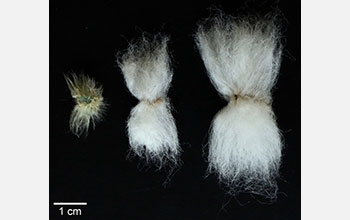Multimedia Gallery
Comparison of different species of cotton
Upland cotton (right), evolved from the hybridization of two ancestral species, one similar to G. raimondii (left) and one similar to G. arboreum (middle), and has longer fibers than either. Researchers have taken the first step toward a new way of breeding heartier, more productive cotton through a process called epigenetic modification.
More about this image
In recent decades, scientists have discovered that many traits in living things are controlled not just by their genetics, but also by processes outside their DNA that determine whether, when and how much the genes are expressed, known as epigenetics. This opens up the possibility of entirely new ways to breed plants and animals. By selectively turning gene expression on and off, breeders could create new varieties without altering the genes.
Research led by Z. Jeffrey Chen, the D.J. Sibley Centennial Professor of Plant Molecular Genetics in the Department of Molecular Biosciences at The University of Texas at Austin (UT Austin), and a team have taken the first step toward a new way of breeding heartier, more productive cotton through a process called epigenetic modification.
During their study, the researchers identified more than 500 genes that are epigenetically modified between wild cotton varieties and domesticated cotton, some of which are known to relate to agronomic and domestication traits. This information could aid selection for the kinds of traits that breeders want to alter, like fiber yield or resistance to drought, heat or pests. For example, varieties of wild cotton might harbor genes that help them respond better to drought, but have been epigenetically silenced in domesticated cotton.
"This understanding will allow us to supplement genetic breeding with epigenetic breeding," says Chen. "Since we know now how epigenetic changes affect flowering and stress responses, you could reactivate stress-responsive genes in domesticated cotton."
This research was funded by the U.S. National Science Foundation (grants IOS 1025947 and IOS 1444552).
Read more about this research in the UT-Austin news story First Step Taken Toward Epigenetically Modified Cotton. (Date image taken: 2015; date originally posted to NSF Multimedia Gallery: Nov. 28, 2017)
Credit: Photo courtesy the Chen Laboratory
Images and other media in the National Science Foundation Multimedia Gallery are available for use in print and electronic material by NSF employees, members of the media, university staff, teachers and the general public. All media in the gallery are intended for personal, educational and nonprofit/non-commercial use only.
Images credited to the National Science Foundation, a federal agency, are in the public domain. The images were created by employees of the United States Government as part of their official duties or prepared by contractors as "works for hire" for NSF. You may freely use NSF-credited images and, at your discretion, credit NSF with a "Courtesy: National Science Foundation" notation.
Additional information about general usage can be found in Conditions.
Also Available:
Download the high-resolution JPG version of the image. (238.8 KB)
Use your mouse to right-click (Mac users may need to Ctrl-click) the link above and choose the option that will save the file or target to your computer.

 All images in this series
All images in this series